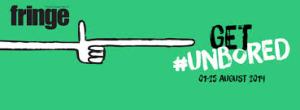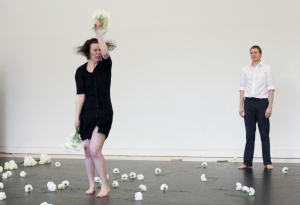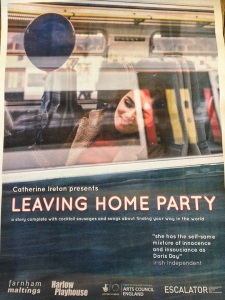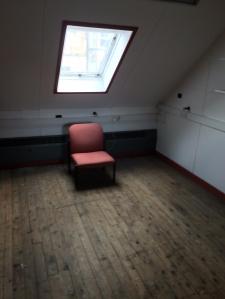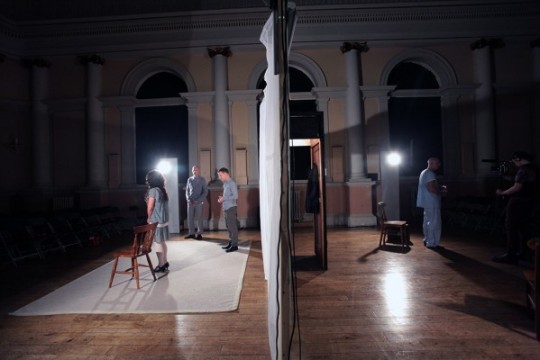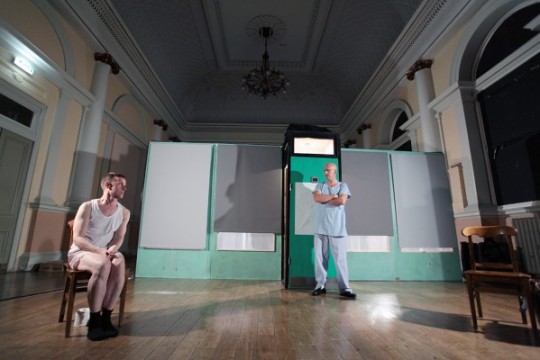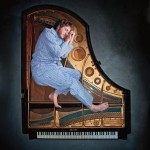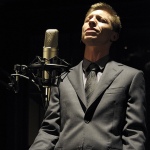The theme of this year’s Edinburgh Fringe Festival is “unboring,” and “get unbored” but not all the shows live up to this.
Two of the shows I saw featured a young woman telling a true story of her life with the accompaniment of a male partner and music.
Near Gone
In Near Gone, Katherina Deva tells of a near death experience of her 4-year old sister.
She tells the story in her native Bulgarian language and Alister Lownie, her partner in Two Destination Language, translates. It is a story of sorrow and pain, intermingled with criticism of medical and city services in Sofia. The story is told sparingly, though some of the words are uttered repeatedly. Punctuating the words, loud recorded music plays (mostly Balkan wedding music of Goran Bregovic) and Katherina moves and dances in a frenzy. She clutches bunches of carnations (400 flowers in total during the performance) which break and fly wildly in the air.
Though it is clear that Katherina’s dance is one of pain, the show draws a thin line between celebration and mourning. Bregovic’s band is called the Wedding and Funeral Orchestra and the music, the flowers and even the dancing could easily be part of either. I found the story, music and dancing too repetitive and was bored. The deep pain and suffering exhibited by Katherina was hard to reconcile with the ultimate positive outcome (which I had guessed from the name of the show).
Leaving Home Party
In Leaving Home Party, Catherine Ireton tells of leaving her Irish hometown to move to Glasgow a couple years after college. She is afraid she will end up spending her life without seeing the world. She admires an aunt who travelled extensively during her life, but died right near her birthplace, but when Catherine leaves home, she feels like an outsider and overwhelmed by the differences (I admit, I had trouble understanding her culture shock—of all the places one could move, Scotland doesn’t seem so different from Ireland).
The show is a musical, with Ireton singing original songs with words that relate to the narrative. She is accompanied by Ignacio Agrimbau on keyboards, guitars and a number of less familiar instruments like a Thai khaen, a Cuban tres and a cajon. (His instrumentals are the best part of the show).
Ireton describes how she is not in control of her life. She turns down a two year cellphone contract but spends more than two years with pay as you go. She works dead end jobs and follows projects brought to her by friends and boyfriends. She says she allows her life to be guided and determined by others.
Eventually she heads back to Ireland and then has an epiphany. What that is is not clear. Does she stay in Ireland? Does she go back to Scotland? Somehow the show is over and the audience is satisfied but I have failed to see a transformation or an explanation for why she feels differently about her life. Has she taken control of her life? Has she decided she is comfortable in Scotland? Also she has failed to mention that perhaps her life is more focused than she lets on. Apparently the reason she originally went to Glasgow was to work with Belle and Sebastian. She doesn’t mention this or any of the successes she had along the way.
My ratings of these shows and the 35 others I saw can be found here.
A number of shows that I saw at the Edinburgh Fringe Festival had formats that I had never experienced in theater before. But, though, I found them interesting, they were not successful.
Before attending the Fringe Festival (this was my first year), I decided to rate each show that I saw on a one to five scale. My friend Nanette and I agreed on what each rating meant and as we left each show we shared our ratings with each other. A three-star rating was for shows that we enjoyed. More than that, for shows we would enthusiastically recommend. I noticed along the way that there were a few shows that I had high hopes for because I anticipated something different, but ultimately I was disappointed and had to rate them less than a three.
Theater on a Long Thin Wire
One of those shows was Theater on a Long Wire (by Jack McNamara, artistic director of New Perspectives Theatre). The audience for each performance is limited to 16 people. We entered a small attic space at the Summerhall theaters—there was a chair with a cellphone on it. The phone rang. It took the group of strangers a couple of seconds to realize that someone needed to answer it. I actually tried to do so, but instead, accidentally hung up on the call. Now what? The phone rang again and someone else stepped in to answer it. The whole theater performance consisted of audience members repeating the words of the “performer” to the rest of the group. (What happened to speakerphones?)
The caller told us of his fear of leaving his room he was in. He then described leaving his room and coming to see us. The only suspense in Theater on a Long Thin Wire was whether we would actually see the performer (though, since the show describes itself as theater without actors, the suspense was limited). He said he had reached the building and was on his way up the stairs. Yes, my imagination was working—I was picturing the building I had just entered and the stairs I had gone up to get to this room. I was wondering what the performer looked like. But isn’t that the purpose of reading a book—your mind creates all of the images of the written word? What happens when theater becomes an uninteresting audio book?
Following the directions of the person at the other end of the line, the phone was handed off to three others and then back to the first. Sometimes the caller requested that everyone repeat specific phrases, or clap, or look out the window. I wondered why we all followed the directions to a “T”. Though two people left the room early in the show, the rest of us did exactly as we were told. I also found it interesting to observe how people ended up with the phone. Is that what the show was about? Group dynamics? Co-operation? Leadership? Conformity? If so, it was done at the expense of boredom.
I gave the show 2 stars—I didn’t like it. It held my interest because I kept hoping for more, but in the end, there was no pay off. The Fringe Festival’s theme this year is “unboring”. The telephone caller in Theater on a Long Wire didn’t get the message.
The Eradication of Schizophrenia in Western Lapland
Another unique theater experience was The Eradication of Schizophrenia in Western Lapland. The stage is divided in two. Audience members are split. Some start out on one side and some, the other. Halfway through the show, the audience switches sides.
The two parts of the stage are divided by a wall with windows. Window shades block the view of the other side of the stage. When the performance started, I could hear some of what was happening on the other part of the stage. Occasionally actors from that side would enter the stage on my side. At some point the shades were lifted and I had a better view of the other stage.
On my side, I was viewing a man in a blue hospital outfit. Doctor or patient? An actor comes from the other side of the stage and sits on a chair—apparently he is a patient and the man in blue is his psychiatrist. On the other side, from what I can here, there is a family—perhaps a mother and her sons. Is this the past of the patient? Are these voices he is hearing? The psychiatrist seems to be troubled as well. Is he hearing voices too? We get a glimpse of an actor on the other stage—he looks very much like the psychiatrist. Is there some relation? Are some aspects of the family on the other side actually part of the psychiatrist’s past or present?
When we switch to the side with the family, what is happening is just as elusive. The words spoken are bits and pieces, there isn’t a real conversation. The mother speaks about Dracula, saying that he was Irish. The characters discuss what to eat and ask where father has gone.
None of my questions are answered and I never get enough clues to make sense of it all.
For me, one of the more interesting aspects of the show relates to multi-tasking. The second half of the show is, for the most part, a repeat of the first half—but now seen from the other stage. During the second half, I hear sentences spoken that I didn’t notice before. Some of those sentences come from the side of the stage I was originally sitting on. How did I miss those sentences the first time round? Was my mind wandering? Was I listening to the other side of the stage? Another thing I found interesting was the difference between just hearing something and having both audio and visual. I hear a shaking sound from the other side of the stage and remember the facial expressions of the actor trying futilely to open a pill bottle, but then I hear a similar sound that I don’t remember and can’t visualize. But these things aren’t interesting enough to sustain me.
The theater group, Ridiculusmus, says the play is inspired by a treatment method for psychosis involving open dialogue (as opposed to drugs) that has virtually eradicated schizophrenia from Western Lapland. How this play relates to that treatment method is unclear to me. I didn’t see a transformation or improvement in the character that clearly suffered from psychosis and I didn’t see (or hear) anything I could understand as open dialogue. It seemed that some sort of psychosis was being experienced by more than one character on the stage—and that it was not in a process of being eradicated.
My rating: 2.5 stars
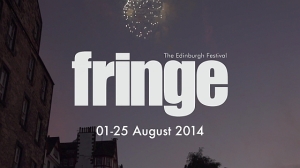 In the six days that I spent at the Edinburgh Fringe Festival, I saw 37 shows. I have already rated the first 19. Below are my combined ratings for all 37 shows.
In the six days that I spent at the Edinburgh Fringe Festival, I saw 37 shows. I have already rated the first 19. Below are my combined ratings for all 37 shows.
I gave a full five stars to three shows:
The Object Lesson, an original work of theater in an interactive space full of junk and boxes of stuff. A one man show conceived and performed by Geoff Sobelle, it is illusion, stunt and comedy that makes us think about all those objects we surround ourselves with.
Cuckooed, also a one man show, was written and performed by Mark Thomas, an English comedian, TV personality and political activist. He describes being deceived by a fellow member of the Campaign Against Arms Trade, who turned out to be spying for Europe’s largest arms company. The show deals with surveillance and deception as well as friendship and trust. It is funny, personal and clever. Apparently, Cuckooed has been in the works for a while–a 2007 article that Thomas wrote in The Guardian in 2007 provides the outline.
Forgotten Voices is a reading by five actors based on the words of people who lived through World War I. I saw the show on the eve of the 100th anniversary of the U.K.’s entry into the war. The show ended just before the strike of midnight and was followed by a bagpipe tribute. It was a very moving evening.
Some facts:
14 of the 37 shows had a single performer.
9 of the 37 shows involved some sort of audience participation
8 involved mourning the death of a parent, sibling or child
I gave 23 out of 37 a rating of at least 3 stars. In other words, I liked 60% of the shows I saw. If you add in the shows with 2.5 stars, an additional 10% of the shows at least held my interest.
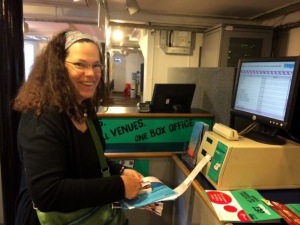
Picking up tickets for the Fringe Festival
MY SCOREBOARD:
5 Stars (excellent, mesmerizing, original)
Cuckooed
The Object Lesson
Forgotten Voices
4 Stars (I really enjoyed it)
Last Christmas
Crazy Glue
Shame
The Carousel
Hannah Gadsby
Kraken
Circa Beyond
White Rabbit Red Rabbit
Every Brilliant Thing
SmallWar
3.5 stars
Margaret Thatcher Queen of Soho
Title and Deed
Klip
3 stars (I enjoyed it)
The Big Bite-Sized Breakfast Show–Menu 1
The Big Bite-Sized Breakfast Show–Menu 2
Chef
Café Ruse
Freak
Light
Initiate
2.5 stars (held my interest but can’t say I enjoyed it)
The Eradication of Schizophrenia in Western Lapland
Pioneer
Notoriously Yours
2 stars (didn’t like)
Theatre on a Long Thin Wire
Show 6
1.5 stars
Re: Fujisan
Anatomy of the piano
Near Gone
Leaving Home Party
Elephant Room
1 star (Disliked, found annoying, hated)
Lexicon lady
Confirmation
0 stars (I walked out)
Silent Voice
Glen Cosby: Food Junkie
After three days of the Edinburgh Fringe Festival I have seen 19 shows.
I gave just only one show a full five stars: The Object Lesson, an original work of theater in an interactive space full of junk and boxes of stuff. A one man show conceived and performed by Geoff Sobelle, it is illusion, stunt and comedy that makes us think about all those objects we surround ourselves with.
Interestingly, of the eleven shows with three or more stars, seven were a single performer.
The shows included one (Theatre on a Long Wire) where the actor only appeared by phone and not even a speaker phone (one of the 16 audience members had to repeat the actors words), one which combined storytelling with movement and hip hop (Shame) and another (Margaret Thatcher) which featured men in drag and 80’s disco music.
5 Stars (excellent, mesmerizing, original)
The Object Lesson
4 Stars (I really enjoyed it)
Last Christmas
Crazy Glue
Shame
Carousel
Hannah Gadsby
3.5 stars
Margaret Thatcher in Soho
Title and deed
3 stars (I enjoyed it)
Big bite sized breakfast
Chef
Café Ruse
2.5 stars (held my interest but can’t say I enjoyed it)
The eradication of schizophrenia in western Lapland
Pioneer
2 stars (didn’t like)
Theatre on a Long Thin Wire
1.5 stars
Re: Fujisan
Anatomy of the piano
1 star (Disliked, found annoying, hated)
Lexicon lady
0 stars (I walked out)
Silent voices
Food junkie
 The Edinburgh Fringe Festival starts in less than a month. There will be about 3,200 different shows across about 300 venues. They come under the categories of theater, comedy, spoken word, music and dance, physical theater and circus. To make things more complicated, there are a few other festivals going on at the same time.
The Edinburgh Fringe Festival starts in less than a month. There will be about 3,200 different shows across about 300 venues. They come under the categories of theater, comedy, spoken word, music and dance, physical theater and circus. To make things more complicated, there are a few other festivals going on at the same time.
PLANNING FOR THE FRINGE
This is my first time at the Fringe Festival and I searched high and wide on the internet for tips, guides, advice, anything on how best to attack the festival. When during the festival should I go (the festival is 25 days long, and I was planning to go for a week)? Should I buy tickets for shows in advance? What part of town is the best to stay in? How long does it take to get from venue ABC to venue DEF? How many shows should I try to see each day. Which shows are best bets? hot tickets? When do I eat? Is there free wi-fi at the venues? Anywhere else?
There doesn’t seem to be anyone writing about these things. I found the site fringeguru.com which had some general info. In terms of which shows might be of interest, I saw a couple of articles in newspapers giving their picks–two in The Guardian– one focused on theater and the other on comedy– one in The Scotsman and one on a website called Giggle Beats. But not much more.
DECIDING WHEN TO GO
I knew that the shows will start to get reviewed at the beginning of the festival and that many people wait and rely on those early reviews to help them decide what to see. I knew that for that reason many people go later in the festival. Also the Edinburgh International Festival and the Edinburgh Book Festival are towards the latter half of the festival, so people who want to go to all of the festivals will also go later.
Always the contrarian, I decided to go at the beginning of the festival–I thought this way I would be able to avoid some of the crowds and take advantage of preview- and 2 for 1- priced tickets and lower hotel rates. This means I have had to pick shows and make my schedule without the benefit of any reviews.
DECIDING WHERE TO STAY
In terms of where to stay, I decided I wanted to be as close to the hub of the venue map as possible. I started booking hotels in September 2013. I couldn’t find the exact place I wanted at a price I wanted–so I triple booked. Three hotels, all prepaid, but cancelable. They were all a little further out than I wanted–one above Queen Street and two in New Town. Since I don’t know Edinburgh, it is hard for me to judge how long it would take to walk from those hotels to some of the venues towards the south, like Assembly and Zoo. Instead of deciding between the three hotels, I took another look and yesterday found something right smack in the center at a reasonable price. I was ready to lock in my reservation–and cancel the others.
DECIDING WHAT TO SEE
I decided to go to the Fringe Festival early last summer–so last year I monitored the festival website to get a sense of how quickly things began to sell out. It seemed like there weren’t a lot of sellouts at the beginning of the festival, so I wasn’t too worried about buying tickets in advance. I did want to have a base schedule though to make the most of my time. I also wanted to co-ordinate the list with the friend I am going with. This year, I’ve noticed a number of shows already selling out certain days–so I started to get panicky about purchasing tickets. I decided to focus on the principal theater venues. My friend and I came up with lists of our top choices and our second choices and then merged our lists. Today, I purchased tickets for 24 shows. All of our top picks and some of our seconds:
Summerhall
Theatre on a Long Thin Wire
Near Gone
Anatomy of the Piano
Leaving Home Party
The Object Lesson
Klip
The Eradication of Schizophrenia in Western Lapland
Traverse Theatre
SmallWar (I saw Valentijn Dhaenens do his one man show BigMouth at the Under the Radar festival in January and was blown away. I hoping for more of the same)
Cuckooed
The Carousel
Northern Stage
Confirmation
Zoo

Hannah Gadsby
Pioneer
Assembly (George Square)
Hannah Gadsby: The Exhibitionist
Last Christmas
White Rabbit Red Rabbit
Assembly Hall
Title and Deed by Will Eno (I saw two plays by Eno this year–Open House and The Realistic Joneses and wanted to see another)
Roundabout

Every Brilliant Thing
Every Brilliant Thing
Show 6
The Initiate
Pleasance Courtyard
Forgotten Voices (Though not generally interested in war history or anniversaries, I thought that it would be interesting to attend the special performance of this on the eve of the 100th Anniv. of the UK’s entry into WWI. The show is timed to end at midnight)
Pleasance Dome
Light
Underbelly
Circa: Beyond
Chef
Shame
APP FRUSTRATION
After I purchased the tickets, I downloaded the Edinburgh Fringe app onto my iPhone. At first I was impressed. There is an easy way to look up a venue and show it on a map. There is a list of all the shows–which you can filter by date and time. But when I logged in to see the shows that I purchased, only 11 of the 24 are showing up–even though most of them were in the same order. I deleted the app and reloaded it, thinking that maybe the sync got interrupted, but I had the same result! Oh well . . .
GOING TO THE FRINGE? DO YOU BUY YOUR TICKETS IN ADVANCE? WHAT ARE YOU SEEING?
